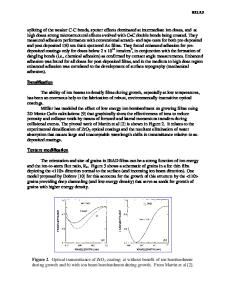Electron Beam Assisted Chemical Vapor Deposition of Gold in an Environmental Tem
- PDF / 2,124,344 Bytes
- 6 Pages / 414.72 x 648 pts Page_size
- 100 Downloads / 307 Views
ABSTRACT We demonstrate a novel technique for in situ observation of the chemical vapor deposition of high purity gold using ethyl(trimethylphosphine)gold(I). An environmental transmission electron microscope with 3.8 eV resolution was used to observe and compare the growth of the material with or without electron beam irradiation (120 keV) with Si (100) substrate temperatures ranging from 125-200 'C. Typical precursor pressures of 10-4 Torr and E-beam irradiation resulted in rapid growth of virtually continuous gold films. Thermal deposition without the beam resulted in low nucleation densities, low deposition rates, and island-like growth. Images and diffraction patterns acquired during the deposition process indicated polycrystalline gold and elemental analysis at the nanometer scale showed that the films had excellent chemical purity. Atomic force microscopy was also used to investigate the three dimensional morphology of the materials. The most notable result of the deposition process is the dramatic enhancement of the growth rate due to the beam irradiation.
INTRODUCTION In situ, real time studies of thin film growth by chemical vapor deposition (CVD) are generally hindered by the corrosive chemical environment and the hostile conditions such as high temperatures and pressures employed during this process. In MOCVD (metal-organic CVD) of metals such as Cu, Al, and Au, understanding the initial stages of microstructural evolution on substrate surfaces is important because these elements are widely used in the microelectronics industry for bonding and wiring. 1 High purity films of these metals can be selectively grown by CVD techniques through insulators for multilevel interconnects in a very conformal manner.2 The role of metal film microstructure on interconnect reliability will become more of an issue as feature sizes shrink. CVD processes are potentially quite attractive for wafer scale metallizations, thus an in situ technique for investigating the early stages of CVD metallization can be highly advantageous in terms of assessing the precursor selection and design as well as determining conditions for optimum film growth. In this report, we focus on the use of a new technique we recently developed to observe the early growth stages of Au films on silicon substrates in an environmental transmission electron microscope (TEM). A Phillips 400T TEM operating at 120 keV and equipped with a differentially pumped environmental cell was used in this study. The original function of the cell was to study interactions between gases and solid specimens at elevated temperatures and pressures while imaging the reaction process. We have successfully applied this apparatus to 323
Mat. Res. Soc. Symp. Proc. Vol. 388 0 1995 Materials Research Society
perform chemical vapor deposition experiments with Al utilizing simple chemical precursors as feedstock gases. 3 In a typical deposition experiment, the gaseous molecular species were allowed to react on a resistively heated substrate in the cell chamber while continuously
Data Loading...










